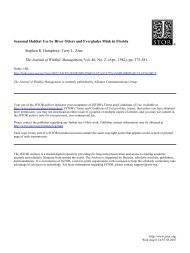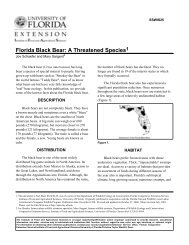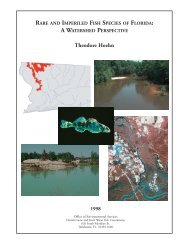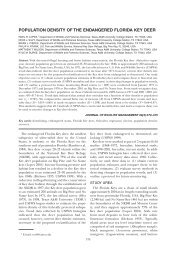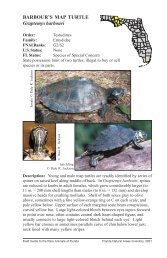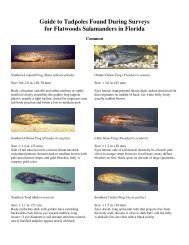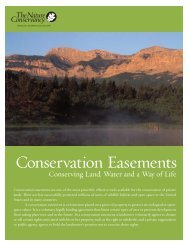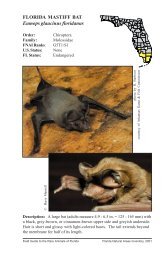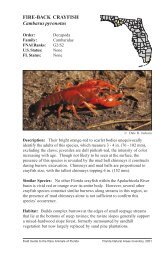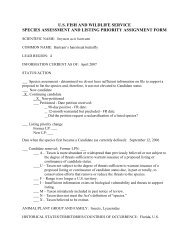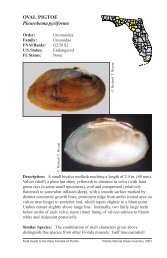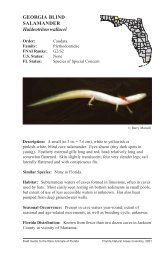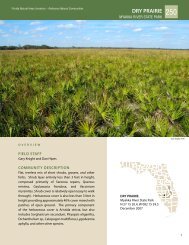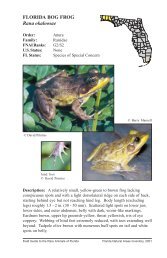American Alligator - Florida Wildlife Conservation Guide - Florida ...
American Alligator - Florida Wildlife Conservation Guide - Florida ...
American Alligator - Florida Wildlife Conservation Guide - Florida ...
Create successful ePaper yourself
Turn your PDF publications into a flip-book with our unique Google optimized e-Paper software.
AMERICAN ALLIGATOR<br />
<strong>Alligator</strong> mississippiensis<br />
Order: Crocodylia<br />
Family: <strong>Alligator</strong>idae<br />
FNAI Ranks: G5/S4<br />
U.S. Status: Threatened by Similarity of Appearance<br />
(to more endangered crocodilians)<br />
FL Status: Species of Special Concern<br />
Harvest of alligators and eggs is regulated by <strong>Florida</strong><br />
Fish and <strong>Wildlife</strong> <strong>Conservation</strong> Commission.<br />
© D. Bruce Means<br />
juvenile © Jim Solomon<br />
Description: A large, mostly black crocodilian with a broadly rounded<br />
snout. Young with yellow crossbands on back, tail, and sides; throat and<br />
belly white to creamy yellow at all ages. Head smooth in front of eyes; no<br />
prominently visible tooth in lower jaw when mouth is closed. Adults 6 -15<br />
ft. (1.8 - 4.6 m); hatchlings about 9 in. (230 mm).<br />
Field <strong>Guide</strong> to the Rare Animals of <strong>Florida</strong> <strong>Florida</strong> Natural Areas Inventory, 2001
AMERICAN ALLIGATOR<br />
<strong>Alligator</strong> mississippiensis<br />
Similar Species: Spectacled caiman (Caiman crocodilus), introduced in<br />
southern <strong>Florida</strong>, shares broadly rounded snout but rarely exceeds 6 ft.<br />
(1.8 m) and has curved bony crosswise ridge in front of eyes; varies from<br />
yellow-green to gray-brown with dark crossbands. <strong>American</strong> crocodile<br />
(Crocodylus acutus; see species account) is gray to brown and has long,<br />
tapered snout with prominently projecting fourth lower tooth when mouth is<br />
closed (except in very young).<br />
Habitat: Most permanent bodies of fresh water, including marshes,<br />
swamps, lakes, and rivers. Occasionally wanders into brackish and salt<br />
water but rarely remains there.<br />
Seasonal Occurrence: Most active from spring through fall, with nesting<br />
in late spring and hatching in summer. Inactive during cold weather, though<br />
some may bask on sunny winter days.<br />
<strong>Florida</strong> Distribution: Statewide, though rare in Keys.<br />
Range-wide Distribution: Southeastern Coastal Plain from North<br />
Carolina to Texas.<br />
<strong>Conservation</strong> Status: Has recovered dramatically since 1960s.<br />
Populations are present on most federal, state, and private conservation<br />
lands where there is permanent fresh water. Several populations are now<br />
large enough to support controlled harvest. Threats include destruction and<br />
pollution of wetlands, including lakes and rivers.<br />
Protection and Management: Protect wetlands of all types from ditching,<br />
filling, and pollution.<br />
Selected References: Ashton and Ashton 1991, Bartlett and Bartlett 1999,<br />
Conant and Collins 1991, Deitz and Hines 1980, Delany and Abercrombie<br />
1986, Kushlan 1974, Lazell 1989, Mount 1975, Neill 1971.<br />
Field <strong>Guide</strong> to the Rare Animals of <strong>Florida</strong> <strong>Florida</strong> Natural Areas Inventory, 2001



